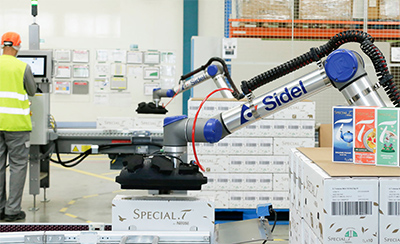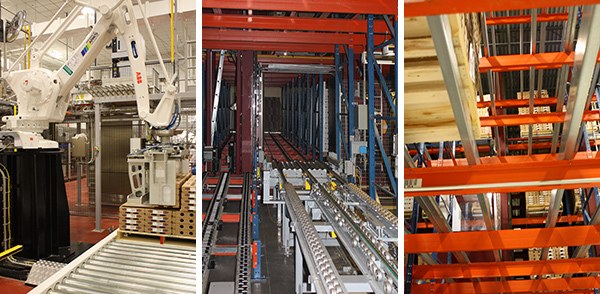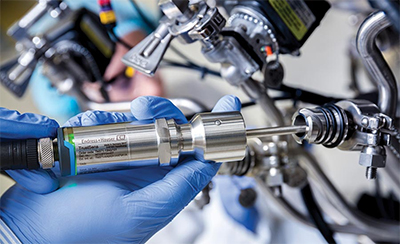2020 Annual Plant Construction Survey: Part 4
Plan a total, plant-wide automation system to improve facility performance and agility
Integrating all the systems on a line is important, but why stop there? Why not include HVAC, refrigeration, boilers, energy management, etc. to get total control?

While we’ve looked at the key issues—including COVID-19—facing food processors and A&E/Cs this year in FE’s 2020 Annual Plant Construction Survey, there’s a lot more to discuss. Parts two, three and four cover:
Part 2: Site related issues beyond wastewater (such as pad-ready sites, weather and flood plains)
Part 3: FSMA facility design criteria, especially in terms of intentional adulteration and food defense
Part 4 (this article): Automation trends: Integration and flexibility
Automation: Key to staying competitive
Automation plays a role from the design of a food plant to the operation of it—including the linking together of process control, HVAC, boiler control, energy management and building control systems—including security. Automation can be complex, but it doesn’t have to be designed that way.
Today’s facility design process could have hardly been visualized two decades ago—partly because the technology wasn’t yet available to make it practical. Like many A&E/Cs, Woodard & Curran has seen the beginnings of augmented reality in the design and operation of facilities, says Lloyd Snyder, senior vice president. This allows the use of design documentation to be used in the operational procedure development. 3-D design and virtual reality are allowing clients to “walk through” the facility design and see how operators interact with systems. It also aids in clash detection and seeing potential construction issues during design to inform design changes.
Balancing automation to be both complex and simple to use and understand
The idea behind all this design technology is to create a food manufacturing plant that behaves in a holistic way, and to do this A&E/Cs say that more and more clients want automation, but they want connected automation systems, and by the way, make it easy for operators and management to understand. And to achieve this level of automation for their clients, some A&E/Cs have built their own automation engineering staff, acquired system integrator (SI) firms or created tight partnering relationships with SIs that can get the job done.
Automation is a balance. The more you automate, the more complicated and the more expensive it can become, says Tammi McAllister, CRB associate, core team leader. For the process it definitely requires finding the balance between human operators and automation. “For HVAC and utilities, we almost always install a building management [system], even if it is simple. With respect to warehousing, most clients would like something automated.” However, that is one expense that doesn’t generally get included in the projects because it is an easy area to reduce cost, says McAllister.
|
|
IIoT ready, the iTHERM Trust Sens TM371/2 is a self-calibrating Pt100 RTD thermometer, which does not need to be removed from the line
|
Simple automation solutions, such as monitoring temperature, are inexpensive but more than make up for what they might cost when they save your product from being spoiled. David Ziskind, Black & Veatch director of engineering, NextGen Ag., explains, “For monitoring temperatures, a chart recorder is nice, until someone forgets to change the paper, a chart gets lost, or is not checked on a regular basis. Instead, especially with the prevalence of IIoT sensors, this data could be historized—added to a historian for long term retention, as well as take actions (such as alarming, sending an email, etc) when out of specification.”
Tim Michalski, department manager at SSOE Group, says his firm has seen in interest in IIoT integration with plant level automation. In addition, equipment upgrades include Cat III safety circuit additions as well as VFD drives to replace motor starters at the same time. Much of the equipment being refurbished and relocated is getting new control systems.
“With better connectivity, smaller sensors and IIoT, we are seeing much more data coming from the field or on-the-floor systems,” says Keith Perkey, VP—Food & Beverage Division, The Haskell Company. “We are seeing more data from machines regarding maintenance cycles, and an increased use of camera systems for security and production monitoring.” The control networks in both processing and packaging systems are becoming faster, more reliable and simpler to install. The automation in the packaging and processing systems often allow for more flexibility to handle a larger variety of products with faster changeovers, says Perkey.
“We are definitely designing more automation into our processes,” says Tamara Zupancic, director of marketing for The Austin Company. “Labor is getting more difficult to find. [However], we have yet to recommend or see a food processor that is willing to sacrifice quality to increase speed. We are seeking out ways to mechanically assist people in their jobs to produce more product with better safety, while maintaining product quality.”
Automation can solve workforce problems, especially when pandemics seek to remove half your employees from your line. “The integration of robotics into process packaging lines and AS/RS into new projects is now a standard for projects,” says Faithful+Gould’s Gregory Franzen, LEED AP, agrifood subsector lead. The initial reason many clients made this capital investment was due to workforce availability caused by low unemployment, and now with the impact (short term or long term?) of COVID-19, a smaller workforce helps to mitigate the impact of this risk to ongoing operations. New trends are likely to emerge as an outcome of COVID-19; expect to see new projects in HVAC systems, air filtration/purification, employee welfare and biosecurity and similar projects, says Franzen.
 |
Sidel developed a collaborative robot palletizing operation for Nestlé Suisse Orbe. The Sidel CoboAccess_Pal cobots work alongside humans and stack cartons of tea tightly on pallets. Source: Sidel |
Though collaborative robots (cobots) do not always fit so well into the processing side of the plant, due to their performance or the ability to withstand cleaning operations, they are seeing more use in secondary packaging areas, says Jennifer Redmond, marketing director at Food Plant Engineering. Why? “Cobots are easily re-programmable to fit the needs of production and can accommodate different packaging designs,” says Redmond.
There is growing concern about employee safety with automation, especially with robotics, says Redmond. The amount of caging needed, safety interlocks, etc. can increase the cost of automation and reduce the flexibility in producing a variety of products. In addition, if a process is highly automated and there is an issue along the line, the whole line may have to be shut down. This can affect productivity, though it’s important to weigh productivity gains with occasional downtime.
Automation must be flexible and connected to serve a single purpose
“The newest automation systems are focused on flexibility,” says Steve Tippmann, executive vice president of the Tippmamn Group. It used to be big machines moving products; now everything is going smaller scale to be more flexible. An automated system has to be more flexible because the market today has to be able to adapt quickly with more SKUs and higher demands for delivery.
What’s driving the need for flexibility? “We continue to see interest in automation to reduce changeover time and decrease losses during transitions due to demand driving short run cycle times,” says Matt Williamson, director of engineering for ADF Engineering.
But for a plant to be truly flexible, all of its systems must work together in concert as a single machine dedicated to producing a product efficiently and with a minimum number of rejects. When automation came on the scene in earnest two or three decades ago, not all plant floor equipment could easily be connected into a single automation scheme—let alone connecting with boiler, energy management or environmental control systems.
Many, many years ago when Detroit automakers were wrestling with “islands of automation,” I remember Honeywell coming out with an application-specific building/HVAC controller, and I wondered whether it would make sense to integrate HVAC/building control with process control systems. At the time, not too many people had thought about the possibility, and it seemed more like a solution looking for a problem. Today, just in the food & beverage industry alone, this concept makes a lot of sense, especially when there are critical processes dependent upon internal environments—for example, milk drying, dough proofing, etc. Chances are, you can think of a few applications as well.
Where to begin? Start with systems that seem only natural to integrate. “Building automation systems for HVAC and refrigeration systems continue to be a focus for our clients that want to conserve energy and increase efficiency,” says Dan Crist, A M King VP of operations. AS/RS and robotic systems are becoming more popular and utilized by clients that haven’t historically integrated these systems. Labor shortages and need for faster production are fueling this trend in processing facilities.
 |
A common place to integrate automation systems is from the palletizer (left) to the AS/RS (right). In the middle photo is the physical connection (rails) from palletizer to AS/RS. Photos: Wayne Labs |
“In the world of processing and packaging, automated systems are now available to serve operators from end to end — from raw materials to finished product,” says Alfredo Valadez, Food & Consumer Products Group, Burns & McDonnell. When weighing investment decisions, it is important for the processor or distributor to have a firm grasp of success and return on investment criteria. Another key factor in these investment decisions is facility size. Smaller facilities will have different breakpoints due to more limited opportunities to meet ROI objectives. A large facility with multiple product lines will have more opportunities to generate ROI through process automation, says Valadez.
Integrating all the systems in a plant remains a challenge as Valadez describes: Food processing automation is a growing trend, but the actual systems in which owners and operators are choosing to invest are extremely varied. Some automated systems are designed to address food safety or security issues. For example, HVAC systems are used to eliminate the chances of cross contamination while smart plant applications help control energy costs. Automation can also be deployed in production to address a wide range of economic factors, including labor scarcity issues.
Security and operator tracking has become a major concern in the last few years, says Jason Paxson, automation engineering manager, Mechanical Process Group, Shambaugh & Son. “We are seeing increased interest in tying all of the utility/building automation systems into the process automation system. This trend allows for communication between the automation system and the utility systems to help with cycling loads and reducing energy usage. This also allows the plant engineer to have a common point to compare energy use with process equipment operation.”
“Gray Solutions, Gray’s digital arm, is seeing process controls trending toward more integration of facility and utility controls systems,” says Gray’s Tyler Cundiff, vice president, business development – food & beverage market. All Gray Solutions’ projects begin with a “Controls & Automation Commonality Document,” which now applies to building systems in addition to process equipment. This allows for communication, data collection, and reporting across the entire facility on one platform—and supports future integration or symbiotic control of both the process and the supporting facility equipment. New processes are being designed with smart scheduling applications where computer models schedule individual processing assets based on product run times, availability, total productive maintenance (TPM), and other real time variables. Automation is continuing the trend toward full robotic solutions for high touch point areas, sampling systems, high volume packaging systems, as well as AS/RS applications, says Cundiff.
Automating maintenance
Automation is providing a tremendous opportunity to communicate information…not just that a line is down, but that the line is perhaps running slower than it did yesterday, says Chris Jarc, P.E., PMP, LEED AP, Hixson Architecture & Engineering vice president, business development - food and beverage market. Advances in wireless data are making it easier than ever before to get data for shop floors, packaging, metering and more. “The sophistication of technology is truly impacting how plants are operated and maintained,” says Jarc.
Leveraging automation for predictive maintenance is of interest (i.e.through IIoT sensors which can detect premature wear), says Ziskind. Integrated and converged systems are of interest—for example, a building automation system (BAS/BMS) which can detect high current draws on a unit or large motor, which might indicate premature failure. Integrated security such as Bluetooth beacons and RFID tracking can provide piece of mind – an operator enters a room, which triggers a camera; the operator’s badge loads up a screen only to what they are authorized to view or control – or even safety implications (such as not starting a machine until detecting there are no people in the area, combined with standard safety components such as light curtains). Emerging manufacturers are looking to scale from very manual operations to a cost effective next step – this may involve more automation, but quality is key especially to these companies and they are generally not interested in sacrificing quality for automation.
—
Resources:
"Integrating process control and building automation systems," FE, May 21, 2018
"Integrating CIP and Process Control," FE, November 26, 2005
"Energy management: crunching the numbers," FE, May 13, 2013
"Solutions for improving yield are within reach," FE, September 26, 2015
—
The following companies and individuals participated in the 2020 Food Engineering Plant Construction Survey:
|
A M King |
ADF Engineering, Inc. |
|
Alberici Constructors |
ARCO National Construction |
|
Big-D Construction |
Black & Veatch |
|
Burns & McDonnell |
CMC Design-Build Inc. |
|
CRB |
Dennis Group |
|
EA Bonelli + Associates |
Epstein |
|
ESI Group USA |
Faithful+Gould |
|
Food Plant Engineering, LLC |
GALBRAITH Pre-Design, Inc. |
|
Gleeson Constructors & Engineers LLC. |
Gray |
|
Hixson Architecture & Engineering |
Mead & Hunt |
|
Shambaugh & Son, L.P. |
SSOE Group |
|
Stellar |
The Austin Company |
|
The Haskell Company |
Tom Wiersma, Independent Consultant |
|
Tippmann Group |
Woodard & Curran |
Looking for a reprint of this article?
From high-res PDFs to custom plaques, order your copy today!








